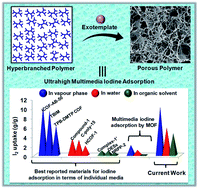Porous polyaminoamides via an exotemplate synthesis approach for ultrahigh multimedia iodine adsorption†
Abstract
Due to its long half-life and volatile nature, efficient removal of iodine from different media (such as vapor, organic solvents and water) is of primary importance for the sustainable production of nuclear energy. Herein we report our work on the preparation of porous polyaminoamides and their applications in the context of removal of iodine from different media. A series of porous polyaminoamides were prepared using sodium bicarbonate (NaHCO3) as the exotemplate, where porosity of the resultant materials can be tuned by varying the amount of exotemplates. The materials show excellent thermal, chemical and radiation stability and iodine adsorption capacities in different media. The iodine adsorption capacity of the best material is determined to be 10.2 g g−1 in the vapor phase, 4.7 g g−1 in the organic phase and 5.9 g g−1 in aqueous medium. These are the benchmark values reported to date among all porous materials. Further their applicability in real world sea water matrices is also tested and the adsorption capacity is reported as 5.8 g g−1 and 5.6 g g−1 in basic and complex sea water matrices respectively. Excellent iodine adsorption capacity in addition to their thermal, chemical, and radiation stability makes them one of the best materials of choice for efficient iodine removal.

- This article is part of the themed collection: Journal of Materials Chemistry A Emerging Investigators


 Please wait while we load your content...
Please wait while we load your content...